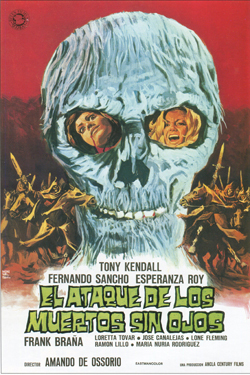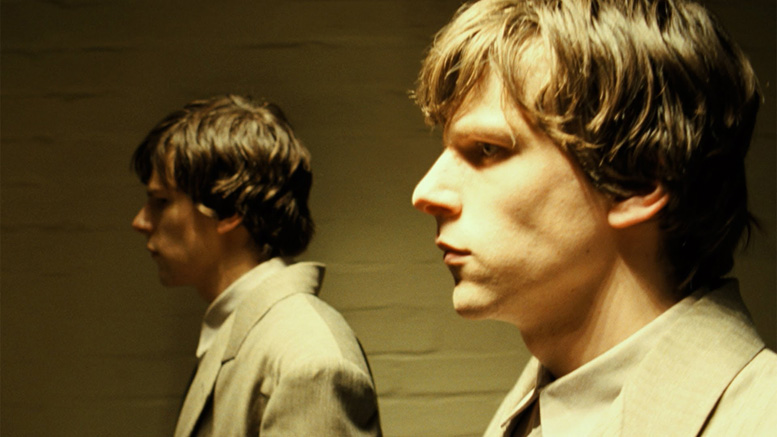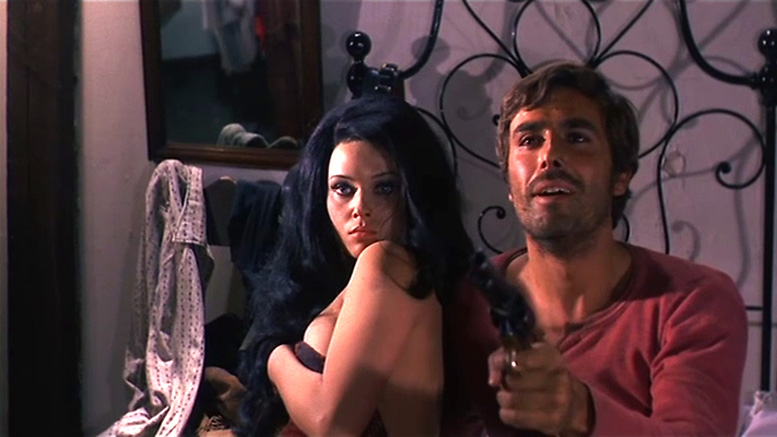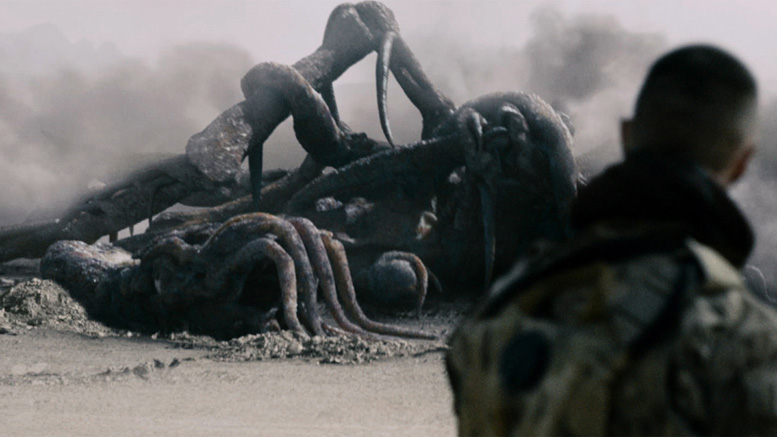Aka Ataque De Los Muertos Sin Ojos (Spain)
1973
Spain
Director: Armando De Ossorio
Script: Armando De Ossorio
Producer: Ramon Plana
Music: Anton Garcia Abril
Cinematography: Miguel Fernandez Mila
Editor: Jose Antonio Rojo
Cast: Tony Kendall [Luciano Stella] (Jack Marlow), Esther Roy [Esperanza Roy] (Vivian), Fernando Sancho (Mayor Duncan), Frank Blake [Frank Brana] (Howard), Loli Tovar [Loretta Tovar] (Monica), Lone Fleming (Analia), Ramon Lillo, Jose Thelman, Luis Barboo (Templar), Jose Canalejas.
Blood drinking and generally heinous dudes The Templars are massacred by a gang of peasants, outraged at their predilection for carrying out human sacrifices. Fearing their ‘supernatural’ powers, the mob is thoughtful enough to burn out their eyes before killing them. Understandably, The Templars are none too happy with this.
Five hundred years later and preparations are underway to celebrate the 500th anniversary of the butchery. Jack Marlow (iconic sixties-sleazeball Tony Kendall) is hired to manage the fireworks display. Before you know it, he’s also managed to cop a grope of Vivian (Esperanza Roy), who happens to be an old flame of his. After a good deal of exposition, the undead (and decidedly chargrilled) heretics rise from the grave to have their revenge.
After most of the villagers have been slaughtered a motley group of survivors (including Marlow and Vivian) are left trapped in the church. Whilst they wait until dawn (and therefore for their attackers to retreat) they pass the time by squabbling amongst themselves. The casual viewer, meanwhile, passes the time by trying to guess which of them will manage to get themselves killed next.

Over the years, Armando De Ossorio’s ‘Blind Dead’ series, of which this was the second entry (following Tombs of the Blind Dead and preceding Night of the Seagulls and The Ghost Galleon) has developed a sizeable cult following. It’s difficult to deny that the films are compulsive, mainly because of the memorable titular zombies. Unable to see, they rely on sound to locate their prospective victims – which leads to much shouting of ‘we’ve got to be quiet’ and the like. They are particularly impressive in longshot, with the scenes in which they ride in a shrouded procession across the Spanish countryside or prowl the medieval village buildings containing a certain element of pure trash-poetry. Unfortunately, they’re less convincing up close, when they seem rather too spindly to be truly fearful. It looks as though all you’d have to do is sneeze and they’d crumble to dust.
The general consensus is the Return of the Evil Dead is the best of the series – a view I find difficult to contradict because I have only had the chance to see Tombs and a grotty dupe of Night of the Seagulls. It definitely benefits from it’s relatively taut scenario, particularly once the central characters are left to do what central characters do best in these ‘siege’ horror films; act in a uniformly stupid manner. The downside of this is that these confined sequences are, in some ways, less memorable than the more surreal passages in which the Blind Dead are simply shown doing their thing.
I do find it interesting the way that Spanish horror cinema seemed to fall into two distinct camps during the early 70s. In the left corner you have the ‘fantastical horror’ as epitomised by this film, the works of Paul Naschy and (sometimes) Jesus Franco. In the right hand corner you have the ‘psychological thrillers’ such as The Corruption of Chris Miller, The Bell of Hell and Island of Death. Both of them seem to share the central subtext of the conflicts between exuberant youth and repressed (not to say self-serving) authority and between the liberated cities and fettered rural society. I must confess that I have grown to much prefer the latter subgenre, which is maybe why I enjoyed Return of the Evil Dead much less than I remember doing upon first acquaintance.
As for the production qualities. Well, De Ossorio was a middling talent at best, and this sees him, fortunately, on top form. Unfortunately he does allow things to drift during the first half (something of a trademark for the director), but it’s not too hard to forgive him that. Both the cinematography and music are more than adequate.
There’s also a fabulous cast. Frank Brana has one of his largest roles, managing to last virtually the entire running time (as opposed to his usual five-minute cameos). He proves to be rather good, and looks like a true groovester in his natty combo of sports jacket and cravat. Fernando Sancho turns in another great villainous performance, particularly when he gets to use a brat as a decoy whilst trying to escape – a tactic which I wholeheartedly applaud. The one downside is Esperanza Roy in the lead female part; I’m sure she’s a fabulous actress but, well, she’s frankly not a babe (especially with those frighteningly plucked eyebrows). This is ‘70s euro-hoke, you know!
The true star is, however, Murdo. The token hunchback, he only has one eyebrow, which makes him look rather like an antsy Liam Gallagher, and would appear to have been dubbed by Beavis, Butthead (or, err, Liam Gallagher). Strangely enough, The templars don’t seem to be that bothered with him – being understandably more interested in pursuing the rather less aesthetically challenged Loretta Tovar. Indeed, when they finally do get round to lopping of his head (not quite sure how they manage to do that without taking off his hunch as well) you can’t help but feel it was more because of his tiresome antics than out of any kind of vengeance-driven bloodlust.



Comments